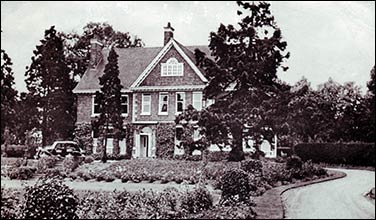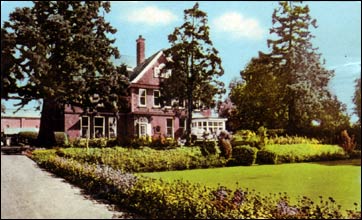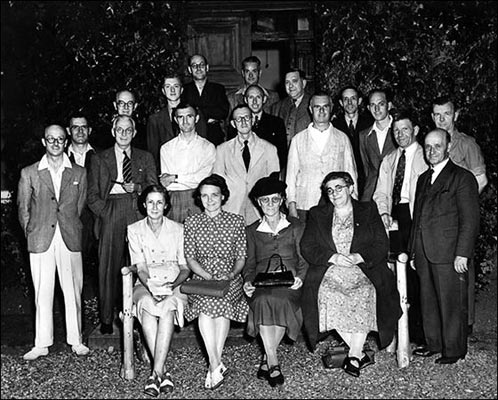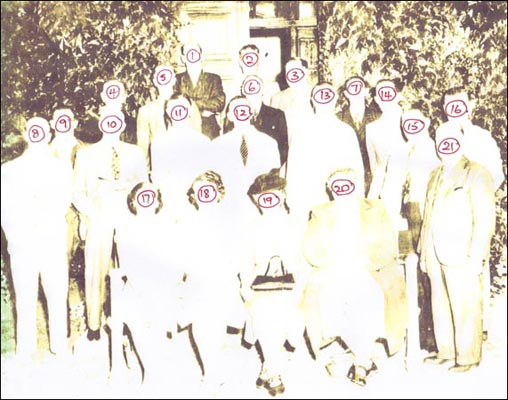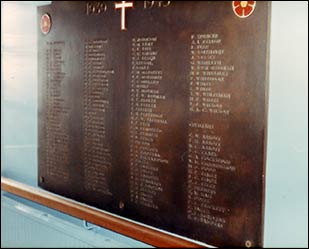|
||||||||||||||||||||||
| Marian Hollomon (formerly Sister-in-Charge Marian Pinnell), 2008 |
||||||||||||||||||||||
|
History of Rushden Memorial Clinic
|
||||||||||||||||||||||
|
||||||||||||||||||||||
|
Fifty eight years on and this picturesque Victorian house has concealed a service to the local public which has grown from strength to strength.
Originally opened in January 1950 to serve the ever growing population of Rushden and the surrounding villages the Memorial Clinic in the Hayway has changed little in its appearance to the public.
George Herbert Claridge continued the family business of supplying leather to the shoe trade in Rushden after his father's and mother's deaths in 1910 and 1925. He lived alone in the family home in Hayway after his brothers and sister married and moved out. He continued to live in the house alone with just the house staff until 1948-49, when he moved into a smaller house in Portland Road Rushden, where he remained until his death at the age of eighty years in 1953. In May and June 1944 open public meetings were held at the Trade Union Hall Rushden. Representatives of the Trade Council and local organisations including the Rushden Hospital Committee decided that Rushden needed a Cottage Hospital – 12 beds. To be called the Rushden Home Hospital, this would be an extension of treatment services already being held in one of the large houses in Griffith Street Rushden. These consisted of physiotherapy and Consultant consultations. Mr Marshall Bailey who represented the ambulance association raised the question of a suitable building being available for adaptation and a suggestion of Eastfields in Victoria Road was made. However the owner was approached and an unrealistic price was asked for so that idea was abandoned. Around December 1944 the committee were informed of suitable premises in the Hayway – Mr. Claridge's house. This house was considered large enough to house at least 15 beds. Mr. Marshall Bailey asked Mr. George Marriott to make enquiries regarding the possible purchase. Mr. Claridge was approached and agreed a purchase price of £5000. In 1945 this money was made available via the Charity Commission which was later paid back after enough appeal money was raised. Donations were also received from local industrialists and business men. A group of trustees was formed for the scheme from Rushden Home Hospital, Wymington Road and Northampton General Hospital.
The trustees were - Dr. D. G. Greenfield, Mr. W. E. Capon, Mr. J. White, Mrs. A. E. Muxlow, Mr. L. W. Bradshaw and Mr. G. Marriott. This appeal was called The Joint Home Hospital & Northampton General Hospital Appeal. In the 1920’s a penny a week was deducted from the factory workers wages to provide them with contributions for medical and surgical treatments along with assistance for specialist treatments and optical glasses. In 1939 this contribution was raised to two pence per week and then three pence per week. The target was £20,000, and by 1945-46 £21,320 had been raised of which £11,000 was from contributions of 6,500 employees working in 9 factories in the town.
On Friday 21st January 1949 the physiotherapy equipment was moved into the ground floor treatment rooms from Griffith Street. On Saturday 29th January 1949 a service of dedication was held conducted by Rev. A. E. Green and Rev. R. Percival Jones the minister of Park Road Baptist Church. During the service a Silver Key was handed over by Sir John Brown, K.C.B., and D.S.O. to Councillor J. H. J. Paragreen, J.P. who performed the opening ceremony. This key was the original front door key and still exists today on display at the clinic. Hundreds of people attended this service of dedication and afterwards entered the building to survey the adaptations. Councillor Paragreen and his wife entertained the committee and visitors to tea and then in one of the upper rooms, the ceremony of presenting the deeds was conducted. The deeds of the house were produced by Mr. A. Norman Groome and handed over by Dr. Greenfield to Mr. A. M. Lee, Chairman of Kettering District Area Management Committee, who said that Rushden had done “a great job.” By Christmas of that year further extensive renovation and alterations were made to the remaining floors for the commencement of various out patient clinics. On October 1st 1950, Sister Florence Margaret Lane S.R.N. with Sister Kathleen Ingham S.R.N. (casual relief Sister from Isebrook Hospital, Wellingborough) and Staff Nurse Putnam S.R.N. were the first nursing staff to arrive to run the out patient clinics. These clinical sessions consisted of Ante natal, Gynaecology, Ear Nose and Throat, and Ophthalmology and would be staffed by consultants from Kettering General and Northampton General Hospitals jointly. From these seeds a vast tree of services has branched out over the years. These services were nurtured by Sister Florence Margaret Lane who married Mr Stanley Lewis in 1976 and retired on August 31st of that year. Her successor was Staff Nurse Marian Pinnell a member of the clinic staff from 1968 who became Sister in Charge from 1st September 1976 – 31st August 2006. Note: in 2011 the Memorial Clinic was sold and the Memorial Plaque has been moved to Rushden Hall. |
||||||||||||||||||||||
